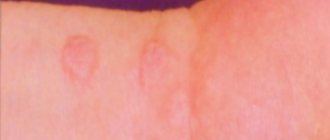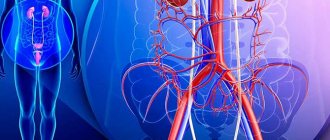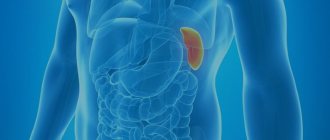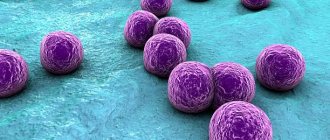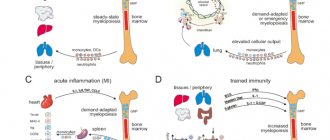Types of dermographism
Depending on the clinical picture, several types of disease are distinguished:
- White dermographism. In the corresponding zone of skin irritation, whitish stripes appear within 3-5 seconds after a small impact on it, which disappear in a few minutes.
- Edema dermographism. At the site of physical irritation, oblong edematous ridges 5–15 mm wide and 1–2 mm high appear. The swelling increases gradually, sometimes over several hours, and disappears very slowly.
- Red dermographism. Characteristic signs are the formation of red hyperthermic stripes in the area of direct skin irritation. They appear 15 minutes after mechanical impact. In the chronic course of the disease, traces remain for an hour or two. The acute stage is characterized by an increase in the time of manifestation of the disease to 1–3 days.
- Urticarial dermographism. It is the most common type of dermographism, accounting for 15% of all skin diseases. With urticarial dermographism, in addition to stripes and spots, an itchy rash appears on the irritated skin.
Prevalence
Collecting information about how much humanity suffers from this condition is complicated by the fact that not everyone notices something unusual in the reaction of their skin, and even fewer people consider it necessary to contact doctors if abnormalities are detected. In this regard, data on how common red dermographism is is difficult to call sufficiently accurate. Researchers talk about 2-5%, but in reality the percentage is most likely higher.
Red dermographism in children occurs quite often at an early age. It can be quite intense and diffuse, but is mainly due to the fact that their skin is more delicate and sensitive and at the same time prone to irritation. However, children are more often diagnosed with other skin diseases (for example, urticaria or dermatitis), rather than red dermographism.
Causes of dermographism
All types of disease have different etiologies. The cause of white dermographism is vasospasm. This form of skin response can occur in any person, but most often develops in asthenic people, in whom the tone of the sympathetic nervous system predominates.
Red dermographism, the causes of which lie in the predominance of the tone of the parasympathetic part of the nervous system, is a response to irritation in the form of capillary dilation.
Edematous dermographism develops as a result of allergies. As a result of mechanical action, the integrity of the mast cell membranes is disrupted. They release histamine, heparin, and serotonin, which cause an allergic reaction. Under their influence, the walls of blood vessels become more permeable, which provokes tissue swelling.
Reflex dermographism is the action of a reflex arc that passes through certain segments of the spinal cord.
Diet therapy
The selection of nutrition for each patient is individual and should be carried out by a nutritionist. Although there are general rules, for example, you should avoid eating spicy and fatty foods, smoked and salty foods, and do not abuse spices, alcohol and carbonated drinks. To enrich your diet, you should include more greens, vegetables, and fresh fruits. Add fermented milk products containing biobacteria and probiotics to your daily diet. The healthiest way to cook food is by steaming; you can also stew, boil, or bake. Don't forget about drinking plenty of fluids.
Folk remedies are also suitable for eliminating the causes and treating red dermographism (see photo below). The most effective were: raw potatoes, nettles and raspberry roots; olive oil; sage and string; valerian and celandine; St. John's wort and chamomile. Decoctions are prepared from herbs, roots and leaves, which are taken orally or used as lotions (especially potatoes).
Signs of dermographism
With white dermographism, after running a stick with a blunt end over the skin, a white stripe immediately appears, disappearing after a few minutes. If the stick is applied with great pressure on the skin, a red stripe is visualized, which will disappear only after a few hours, which is a manifestation of red dermographism.
Severe mechanical irritation of the skin with a stick with a blunt end can provoke edematous dermographism. In this case, first a red stripe forms in the area of direct contact of the skin with the stick, which after 2–3 minutes turns white, swells and swells.
Urticarial dermographism is caused by increased permeability of the vascular walls. As a result, even minor irritation of the skin, such as from the elastic of socks or a trouser belt, leads to the formation of a red stripe surrounded by blisters and a rash.
If you run a sharp needle across the skin, within half a minute a wide red stripe will appear on the surface of the skin. After a few seconds she turns pale and disappears. This is a manifestation of reflex dermographism.
What is urticaria?
This is a dermatological disease caused by a certain irritant, which is accompanied by the following symptoms: the skin turns red and swells, blisters 0.1-1.0 cm in size appear on it. The lesions resemble nettle burns, they bother the patient: they hurt, burn, itch.
Urticaria is a common disease. In children it is more often acute, while adults suffer from a chronic form.
There are 2 ways of developing pathology:
- Immune. Ordinary substances upon first contact with the body, due to improper functioning of the immune system, are perceived by it as hostile - it begins to produce antibodies. Upon repeated contact, the antibodies begin to fight the irritant, causing harm to the person himself - characteristic allergy symptoms appear.
- Non-immune. Antigens (for example, antibiotics) in this case do not require repeated contact, they will immediately provoke antibodies to attach to mast cells and release histamine.
Types of pathology
There are several types depending on the factor that provokes the reaction. Types of urticaria
| View | Provocateur of reaction |
| cold | low temperatures |
| solar | ultraviolet radiation: sun, solarium |
| thermal | heated object |
| cholinergic | overheating of the body, heavy physical activity, stress |
| aquagenic | water |
| contact | natural fabrics, wool and particles of animal epidermis, some plants, cosmetics, topical medications |
| medicinal | medications, in particular antidepressants, non-steroidal anti-inflammatory drugs, acetylsalicylic acid, antibiotics |
| food | products |
| dermographic | mechanical effect on the skin |
| idiopathic | unknown origin: the irritant can be cold, heat, stress, medications, foods |
Diagnostics
Dermographism is not a disease, but only one of the signs of pathology, which can be considered as a symptom in its complete absence or in its strong manifestation.
With pronounced dermographism, one can assume the presence of meningitis, thyrotoxicosis, or autonomic neurosis. The absence of a skin reaction to irritation or its weak manifestation is observed with intoxication of the nervous system or general exhaustion of the body. Therefore, when skin patterns are detected, the patient is referred for examination to differentiate these diseases.
First, a skin reaction test is performed to exposure to a solid object, as well as to cold, water, and heat. If, after an initial examination of the epidermis and the test, a suspicion of dermographism arises, the following studies are indicated:
- immunodiagnostics;
- encephalogram of the brain to diagnose the functioning of the central nervous system.
If necessary, stool tests and blood tests for hormones and parasites may be required.
Dermographism is not a disease, but only one of the signs of pathology, which can be considered as a symptom in its complete absence or in its strong manifestation.
Since dermographism may indicate a number of diseases, consultation with specialized specialists - an immunologist, endocrinologist, neurologist - may be required.
Possible complications
If dermographism is accompanied by severe itching, then when scratching the areas of the epidermis affected by rashes, there is a high risk of bacterial or viral infection. This could be herpes, human papillomavirus, streptococcal or staphylococcal microflora, etc.
If you do not pay attention to the manifestations of dermographism, this can lead to the development of complications. These include:
- exhaustion of the nervous system;
- damage and thinning of the dermis;
- the introduction of infection and the development of inflammatory processes in places where skin rashes and blisters occur;
- Quincke's edema, anaphylactic shock (in rare cases).
Treatment
Treatment of dermographism is carried out only in case of severe manifestations, accompanied by itching. Drug therapy is aimed at eliminating local symptoms and treating the underlying disease.
Prescribed:
- antiallergic drugs (to reduce skin irritation);
- tranquilizers and antidepressants (Diazepam, Phenazepam, Doxepin, Paxil);
- drugs with a sedative effect, including vitamin B;
- ascorbic acid, flavonoids (vitamin P, Rutin) (to reduce the permeability of vascular walls);
- vasoconstrictors (for red and vasodilators for white dermographism);
- antipruritic ointments;
- Ketotifen (in the presence of urticarial dermographism);
- choleretic drugs;
- lactobacilli and bifidobacteria;
- external antiseptics based on camphor and salicylic acid.
Sometimes exposure to ultraviolet light has a positive effect.
With the help of timely identification of the causes that provoke dermographism and their elimination, it is possible to achieve stable remission, and in some cases, completely get rid of such manifestations.
General characteristics of the disease
Direct determination of dermographism as a diagnosis is not difficult - this is easily done by pronounced characteristic manifestations on the skin during a visual examination and testing the skin for mechanical impact. However, this dermatological pathology is rarely an independent disease - most often it is one of the symptoms of the underlying disease.
Diseases that cause dermographism pose a particular danger to a child. They can lead to the development of the following negative consequences:
- damage to various internal organs;
- decreased motor ability;
- changes in hormone levels;
- metabolic disorders at the cellular level;
- change in blood formula;
- disability, asphyxia, death.
Therefore, when the first signs of dermographism appear in children, you should immediately contact your pediatrician. Self-medication is strictly forbidden. Only qualified medical care can provide quality treatment and prevent the development of complications.
The term “dermography” comes from the words derma - skin and grapho - write. Translated from Greek, it means “skin writing” or “skin writing.” In a person suffering from dermographism, the skin is indeed constantly “painted” with various symbols, similar to mysterious inscriptions. They are formed even from minor exposure to seams on clothing, folds of bed linen, or touching with a blunt object. These can be stripes of different sizes and shapes, characterized by slight swelling and redness or paleness of the skin.
With dermographic urticaria, the pressure mark is distinguished not only by a more pronounced change in color, but also by swelling of the skin with itchy rashes on it. Such symptoms persist for several hours or days.
Therefore, when the first signs of dermographism appear in children, you should immediately contact your pediatrician. Self-medication is strictly forbidden. Only qualified medical care can provide quality treatment and prevent the development of complications. Before treating dermographism, a child or adult patient first undergoes a differential examination to identify or exclude the most likely diseases:
- exhaustion, disorder or intoxication damage to the nervous system;
- psoriasis, other dermatoses;
- vegetoneurosis, vegetative-vascular dystonia;
- hyperthyroidism;
- meningitis, disorders of the central nervous system;
- disturbances of sympathetic innervation;
- parasitic infestations;
- increased swelling;
- exposure to allergens;
- hormonal imbalances;
- metabolic disorders;
- autoimmune, cardiovascular pathologies;
- infectious processes in the body;
- hereditary predisposition.
To identify the cause of dermographism, the following are prescribed:
- laboratory tests of blood and feces for the presence of parasites;
- blood test for hormone levels;
- encephalogram of the brain to establish the functionality of the central nervous system;
- immunogram to check the state of the immune system;
- allergy tests;
- Ultrasound of internal organs,
- tomography, x-ray;
- biopsy.
Based on the results of diagnostic studies, the root cause of skin hypersensitivity is determined and a course of treatment is prescribed.
Prevention measures
Primary preventive measures to prevent dermographism have not been developed, since the causes of its occurrence may be different. Secondary measures include activities aimed at preventing relapses.
Doctors recommend wearing loose clothing that does not allow friction or compression of the skin. It is useful to remove all chemicals and personal care products with fragrances from your daily routine, replacing them with hypoallergenic products.
With the help of timely identification of the causes that provoke dermographism and their elimination, it is possible to achieve stable remission, and in some cases, completely get rid of such manifestations. After treatment, most patients note an improvement in their general condition and a decrease in skin sensitivity.
Video from YouTube on the topic of the article:
Therapy
In mild cases (90%), there is no need to treat such a disorder. Marks on the skin disappear on their own after some time and do not leave scars. To relieve symptoms, take sedative antihistamines of the 1st generation: suprastin, diphenhydramine.
But in severe chronic forms, non-sedating antihistamines of the 2nd generation (loratadine) or 3rd generation (cetirizine) are prescribed. They are taken once when manifestations occur or regularly for persistent relapses. For prevention, ketotifen is prescribed; it prevents histamine from entering the tissue.
